

Growing leaf and flower plants inside our homes dates back to ancient times with the use of Roman loggias. It spread during the Renaissance when glass-makers were able to create large, bright windows.
In the 19th century, common rooms began to extensively harbor an even wider range of plants. Hosts tried to created various exotic atmospheres. Here are 6 exceptionally easy and beautiful houseplants with strong ornamental appeal.
Succulent plants offer an extraordinary range of shapes, colors, and blooms. Thus, small plump cacti contrast with tall candelabras, which again are markedly different from the tousled tuft of an elephant’s foot (Beaucarnea).
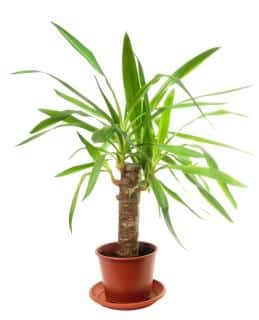 Yucca evokes the arid regions of Mexico. They’re versatile “shrubs” that demonstrate great robustness. For indoor spaces, two species are sold: Yucca elephantipes and Y. aloifolia, along with variegated or purple cultivars. The first, Y. elephantipes, has wide and cascading leaves and tends to branch out. It requires occasional trunk trimming to limit its height. The second, Yucca aloifolia, has slender, tapering, and rigid leaves along a single trunk. Beware, as Yuccas have sharp leaf tips, so place them away from high-traffic areas!
Yucca evokes the arid regions of Mexico. They’re versatile “shrubs” that demonstrate great robustness. For indoor spaces, two species are sold: Yucca elephantipes and Y. aloifolia, along with variegated or purple cultivars. The first, Y. elephantipes, has wide and cascading leaves and tends to branch out. It requires occasional trunk trimming to limit its height. The second, Yucca aloifolia, has slender, tapering, and rigid leaves along a single trunk. Beware, as Yuccas have sharp leaf tips, so place them away from high-traffic areas!
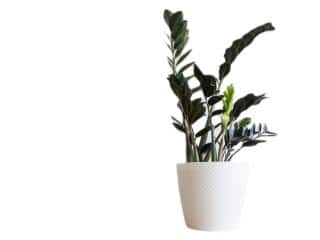 The ZZ plant bears striking fern-like fronds, and each one lasts a very long time – up to a year! There are many different Zamioculcas to choose from, so we’ll only focus on one in particular: the black “Raven” variety. It grows about 2 feet tall (60+ cm) and the fleshy leaves turn blacker and blacker with time and bright light.
The ZZ plant bears striking fern-like fronds, and each one lasts a very long time – up to a year! There are many different Zamioculcas to choose from, so we’ll only focus on one in particular: the black “Raven” variety. It grows about 2 feet tall (60+ cm) and the fleshy leaves turn blacker and blacker with time and bright light.
Subtropical and tropical zones provide us with many plants that are tolerant of our dry indoor environments, such as Ficus and Anthurium. Their glossy, variegated foliage and unusual blooms create a pleasant impression of exotic lushness.
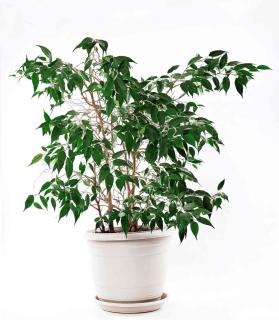 This giant of forests, reaches over 45 feet (15 meters) in height – in the wild! – and has a flexible structure and beautiful oval glossy leaves. It is one of the most favored plants to have made its way into our interiors. Enhance its ornamental aspect with specimens that have twisted or braided trunks. There are also cultivars with cream-variegated foliage like ‘Variegata,’ which brighten up darker corners of the room.
This giant of forests, reaches over 45 feet (15 meters) in height – in the wild! – and has a flexible structure and beautiful oval glossy leaves. It is one of the most favored plants to have made its way into our interiors. Enhance its ornamental aspect with specimens that have twisted or braided trunks. There are also cultivars with cream-variegated foliage like ‘Variegata,’ which brighten up darker corners of the room.
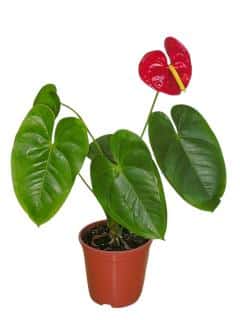 Bright red spathes against dark green foliage: Anthurium has unmatched seductive power! This close relative of the arum produces tiny flowers clustered on a spike called a “spadix,” which emerges from a spectacular red, pink, or white spathe. This floriferous plant with abundant and persistent foliage makes a magnificent decorative element for the home. There are two main species:
Bright red spathes against dark green foliage: Anthurium has unmatched seductive power! This close relative of the arum produces tiny flowers clustered on a spike called a “spadix,” which emerges from a spectacular red, pink, or white spathe. This floriferous plant with abundant and persistent foliage makes a magnificent decorative element for the home. There are two main species:
Clean lines, greenish tones for a soothing effect, these are the characteristics of plants like the dragon tree or peace lily. These low-maintenance plants can tolerate moderate to bright light. With slow growth, they can withstand neglect without showing any signs of withering!
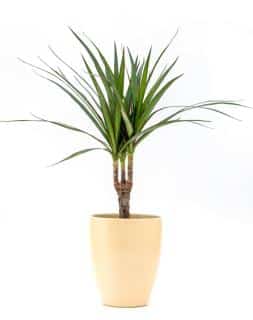 Dragon trees (Dracaena fragans, deremensis, reflexa, or marginata) are characterized by foliage of varying width, arranged in layers along the trunk and with different colors.
Dragon trees (Dracaena fragans, deremensis, reflexa, or marginata) are characterized by foliage of varying width, arranged in layers along the trunk and with different colors.
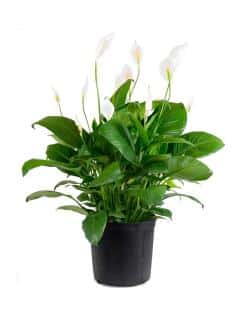 This tropical Araceae has glossy foliage from which greenish to white inflorescences emerge, especially in spring and summer. Similar to Anthurium, it’s the bract surrounding the spike that creates the interest in flowering. This plant can measure between 20 cm and 60 cm depending on the variety and can live for many years.
This tropical Araceae has glossy foliage from which greenish to white inflorescences emerge, especially in spring and summer. Similar to Anthurium, it’s the bract surrounding the spike that creates the interest in flowering. This plant can measure between 20 cm and 60 cm depending on the variety and can live for many years.